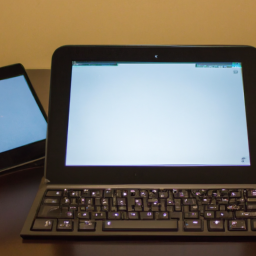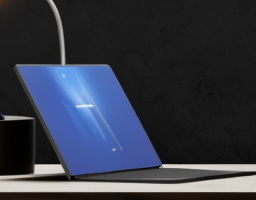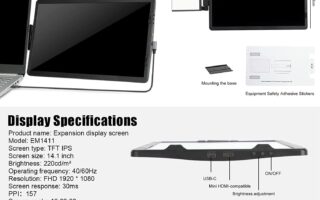Do you ever find yourself needing more screen space while working on your laptop? I mean, let’s face it, sometimes that small screen just isn’t cutting it. Well, lucky for you, there are a couple of options to solve this problem: a laptop screen extender or a secondary monitor. But what exactly is the difference between the two? Let’s dive in and find out!
A laptop screen extender, also known as a screen splitter or dual-screen software, is a technology that allows you to extend your laptop’s display onto another device, such as a tablet or smartphone. It essentially turns your additional device into a second screen that seamlessly connects to your laptop. With a laptop screen extender, you can have different applications open on each screen, making multitasking a breeze. This is perfect for when you need to reference multiple documents or work on different tasks simultaneously. And the best part? You don’t need any additional hardware to use a laptop screen extender. Just download the software, connect your devices, and you’re good to go!
On the other hand, a secondary monitor is an external display that you can connect to your laptop. It functions separately from your laptop’s built-in screen, giving you the flexibility to customize your workspace to your liking. A secondary monitor is a physical device that requires a connection to your laptop, usually through a cable. This means you’ll need to have the monitor on hand and set it up whenever you want to use it. While it may require a bit more effort to set up compared to a laptop screen extender, a secondary monitor offers the advantage of a larger display size and higher resolution. This can greatly enhance your productivity, especially if you work with graphics, videos, or multiple windows open at once.
So, whether you choose a laptop screen extender or a secondary monitor, both options can significantly improve your productivity and make your work more efficient. In the end, it all comes down to personal preference and the specific needs of your work or projects. A laptop screen extender and a secondary monitor are two popular devices used to expand the display capabilities of a computer. While they serve a similar purpose, there are some key differences between the two. In this article, we will explore these differences and help you understand which option is best suited for your needs.
Definition of a Laptop Screen Extender
A laptop screen extender is a device that allows you to connect an additional display to your laptop, effectively extending the available screen space. It comes in the form of a portable monitor that can be easily connected to your laptop via a USB-C or HDMI cable. Once connected, the laptop screen extender acts as a secondary display, providing you with more screen real estate to work with.
Explanation of what a laptop screen extender is
A laptop screen extender is essentially a lightweight and portable monitor that can be used in conjunction with your laptop. It is designed to provide you with additional screen space, allowing you to multitask more efficiently and increase your productivity.
How a laptop screen extender functions
A laptop screen extender functions by connecting to your laptop via a cable, typically a USB-C or HDMI cable. Once connected, it acts as a secondary display, extending the available screen space. This additional screen can be used to display different applications, documents, or websites, allowing you to work on multiple tasks simultaneously.
Definition of a Secondary Monitor
A secondary monitor, on the other hand, is a standalone display that is connected to a computer to provide additional screen space. Unlike a laptop screen extender, a secondary monitor is not specifically designed to be portable and is typically larger in size.
Explanation of what a secondary monitor is
A secondary monitor is essentially an external display that can be connected to a computer to expand its screen real estate. It is commonly used in office settings or by individuals who require a larger screen for tasks such as video editing, gaming, or coding.
How a secondary monitor functions
A secondary monitor functions by connecting to your computer, usually through a VGA, DVI, HDMI, or DisplayPort cable. Once connected, it becomes an extension of your main display, allowing you to drag windows and applications from one screen to another. This enables you to have multiple windows open simultaneously, making multitasking easier and more efficient.
Comparison of Size and Portability
When it comes to size and portability, there are significant differences between a laptop screen extender and a secondary monitor.
Differences in size between a laptop screen extender and a secondary monitor
A laptop screen extender is specifically designed to be compact and lightweight, making it highly portable. It can easily fit in a laptop bag or backpack, allowing you to work on the go. On the other hand, a secondary monitor is typically larger in size and not as portable. It is usually kept on a desk or workstation and is not intended for frequent transportation.
Comparison of portability features
In terms of portability features, a laptop screen extender has the advantage. It is designed to be slim and lightweight, making it easy to carry around. Some models even come with a protective cover that doubles as a stand, allowing you to set up your second display at a comfortable viewing angle wherever you go. A secondary monitor, on the other hand, is usually bulky and requires a dedicated space for setup.
Connection and Compatibility
Both laptop screen extenders and secondary monitors offer various connection options, but there are some differences to consider.
Various connection options available for laptop screen extenders and secondary monitors
A laptop screen extender typically connects to your laptop via a USB-C or HDMI cable. This makes it compatible with most modern laptops and provides a simple plug-and-play setup. Some models may also offer additional connectivity options such as DisplayPort or Thunderbolt. On the other hand, a secondary monitor offers a wider range of connection options, including VGA, DVI, HDMI, and DisplayPort. This makes it compatible with a broader range of devices, including desktop computers and older laptops.
Compatibility considerations for different devices
When choosing between a laptop screen extender and a secondary monitor, it is important to consider the compatibility with your specific device. While most laptop screen extenders are designed to work with various operating systems, it is always a good idea to check the manufacturer’s compatibility list before making a purchase. Additionally, if you plan to use a secondary monitor with multiple devices, you may need to consider compatibility with different ports and connection types.
Display Quality and Resolution
Display quality and resolution are important factors to consider when comparing laptop screen extenders and secondary monitors.
Differences in display quality and resolution between laptop screen extenders and secondary monitors
In terms of display quality, secondary monitors usually offer higher resolution and better color accuracy compared to laptop screen extenders. This is due to the larger screen size and the fact that they are specifically designed for high-quality visual output. Laptop screen extenders, on the other hand, may have lower resolution displays and may not offer the same level of color accuracy. However, for basic productivity tasks such as email, web browsing, and document editing, laptop screen extenders are more than sufficient.
Comparison of color accuracy and viewing angles
Secondary monitors are often equipped with high-quality panels that offer better color accuracy and wider viewing angles. This makes them suitable for tasks that require accurate color representation, such as photo and video editing. Laptop screen extenders, while functional, may not offer the same level of color accuracy and may have more limited viewing angles. However, for everyday productivity tasks, these limitations are generally not noticeable.
Multi-tasking and Productivity
Both laptop screen extenders and secondary monitors can significantly enhance multi-tasking abilities and productivity, but they have their advantages and disadvantages.
Advantages and disadvantages of using a laptop screen extender for multi-tasking
One of the main advantages of using a laptop screen extender for multi-tasking is the portability and flexibility it provides. You can easily set up a second display wherever you go, allowing you to work efficiently in different environments. However, the smaller screen size of a laptop screen extender may limit the number of windows and applications you can have open simultaneously. Additionally, the lower resolution display may impose some limitations on certain tasks, such as graphic design or video editing.
Advantages and disadvantages of using a secondary monitor for multi-tasking
A secondary monitor offers a larger screen size, allowing you to have multiple windows and applications open simultaneously. This can greatly enhance productivity by reducing the need to constantly switch between applications. Additionally, a higher resolution display and better color accuracy make a secondary monitor suitable for tasks that require precise visual representation. However, the larger size and lack of portability may limit its usability in certain situations, such as when working away from your usual workspace.
Additional Features and Functionality
Laptop screen extenders and secondary monitors often come with additional features and functionalities that can enhance your overall user experience.
Unique features and functionalities of laptop screen extenders
Many laptop screen extenders come with built-in speakers, touchscreen capabilities, or integrated battery options. This allows you to use your laptop screen extender as a complete standalone device, eliminating the need for additional peripherals. Some models even offer USB ports for connecting peripherals such as keyboards or mice.
Unique features and functionalities of secondary monitors
Secondary monitors often offer adjustable stands, allowing you to set the display at a comfortable viewing angle. Some models may also include built-in USB hubs, making it easier to connect multiple devices. Depending on your specific needs, you may also find secondary monitors with features like curved screens, ultra-wide displays, or even built-in webcams.
Cost and Value for Money
When it comes to cost, laptop screen extenders are generally more affordable compared to secondary monitors. However, the value for money depends on your specific requirements and intended use.
Comparison of price ranges for laptop screen extenders and secondary monitors
Laptop screen extenders are available at various price points, with entry-level models starting at around $100. Higher-end models with additional features and higher resolution displays can cost upwards of $300. On the other hand, secondary monitors come in a wide range of sizes and features, resulting in a broader price range. Entry-level secondary monitors can be found for around $100, while high-end models with advanced features can exceed $1000.
Factors to consider when determining value for money
When determining the value for money, it is important to consider your specific needs and use cases. If you require a portable solution that allows you to work on the go, a laptop screen extender may offer better value. On the other hand, if you need a larger display with higher resolution and better color accuracy for tasks such as graphic design or gaming, a secondary monitor may be a better investment.
Setting Up and Configuration
Setting up a laptop screen extender or a secondary monitor is usually a straightforward process, but there are some differences to be aware of.
Step-by-step guide on setting up a laptop screen extender
To set up a laptop screen extender, follow these steps:
- Connect the laptop screen extender to your laptop using the provided cable (usually USB-C or HDMI).
- Once connected, your laptop should automatically detect the additional display.
- Adjust the display settings on your laptop to extend the desktop to the second display.
- If necessary, configure the orientation, resolution, and other display settings to your preference.
- You can now start using your laptop screen extender as a secondary display.
Step-by-step guide on setting up a secondary monitor
To set up a secondary monitor, follow these steps:
- Connect the secondary monitor to your computer using the appropriate cable (VGA, DVI, HDMI, or DisplayPort).
- Power on the secondary monitor and ensure it is recognized by your computer.
- Adjust the display settings on your computer to extend the desktop to the second monitor.
- If necessary, configure the orientation, resolution, and other display settings to your preference.
- You can now start using the secondary monitor as a second display.
Conclusion
In conclusion, the main differences between a laptop screen extender and a secondary monitor lie in size, portability, display quality, and functionality. Laptop screen extenders are designed to be compact, portable, and provide sufficient screen space for basic productivity tasks. Secondary monitors, on the other hand, offer larger screens, higher resolution, and better color accuracy, making them more suitable for tasks that require precise visual representation.
When choosing between a laptop screen extender and a secondary monitor, consider your specific needs, preference for portability, desired screen size and resolution, and budget. Regardless of your choice, both options can significantly enhance your productivity and multitasking abilities. Happy exploring and may your new display device bring you many hours of productivity and enjoyment!



